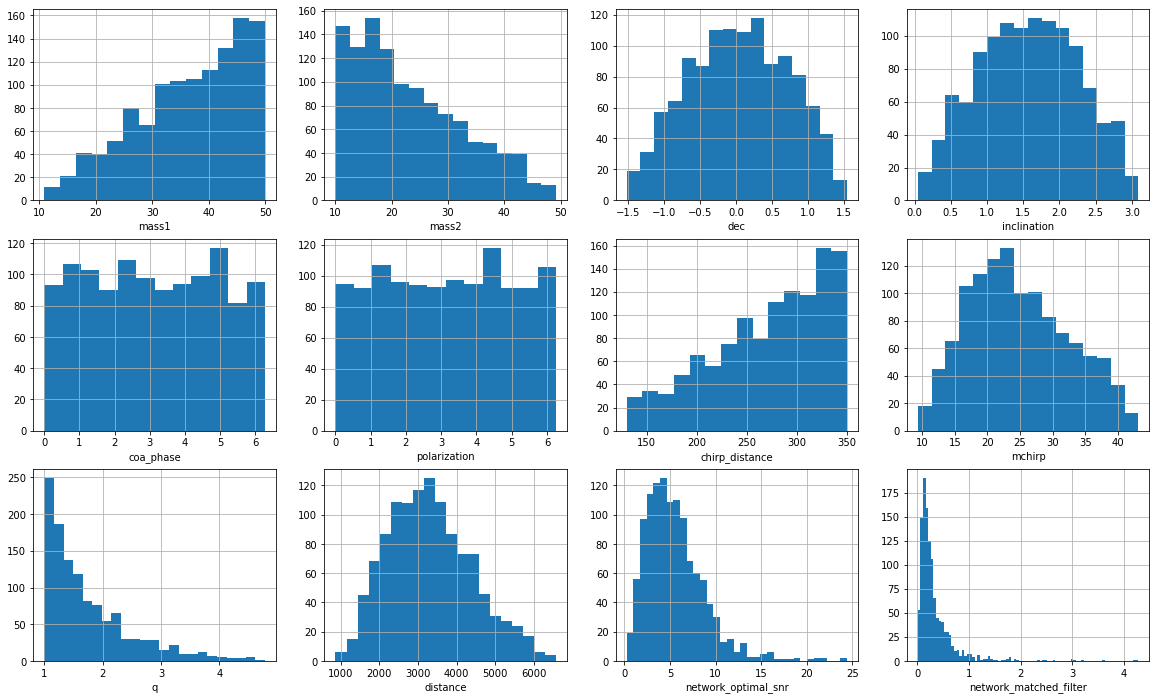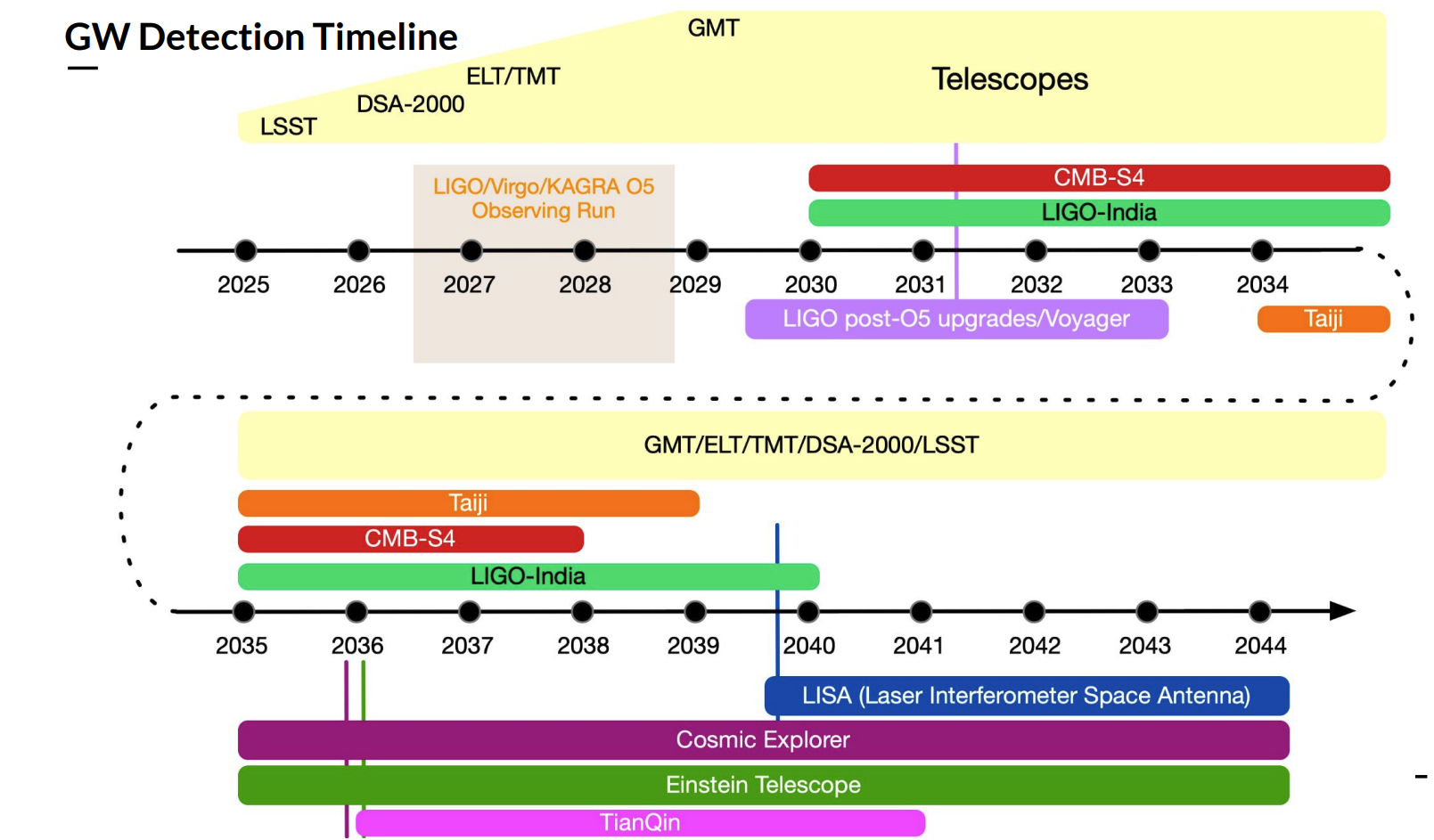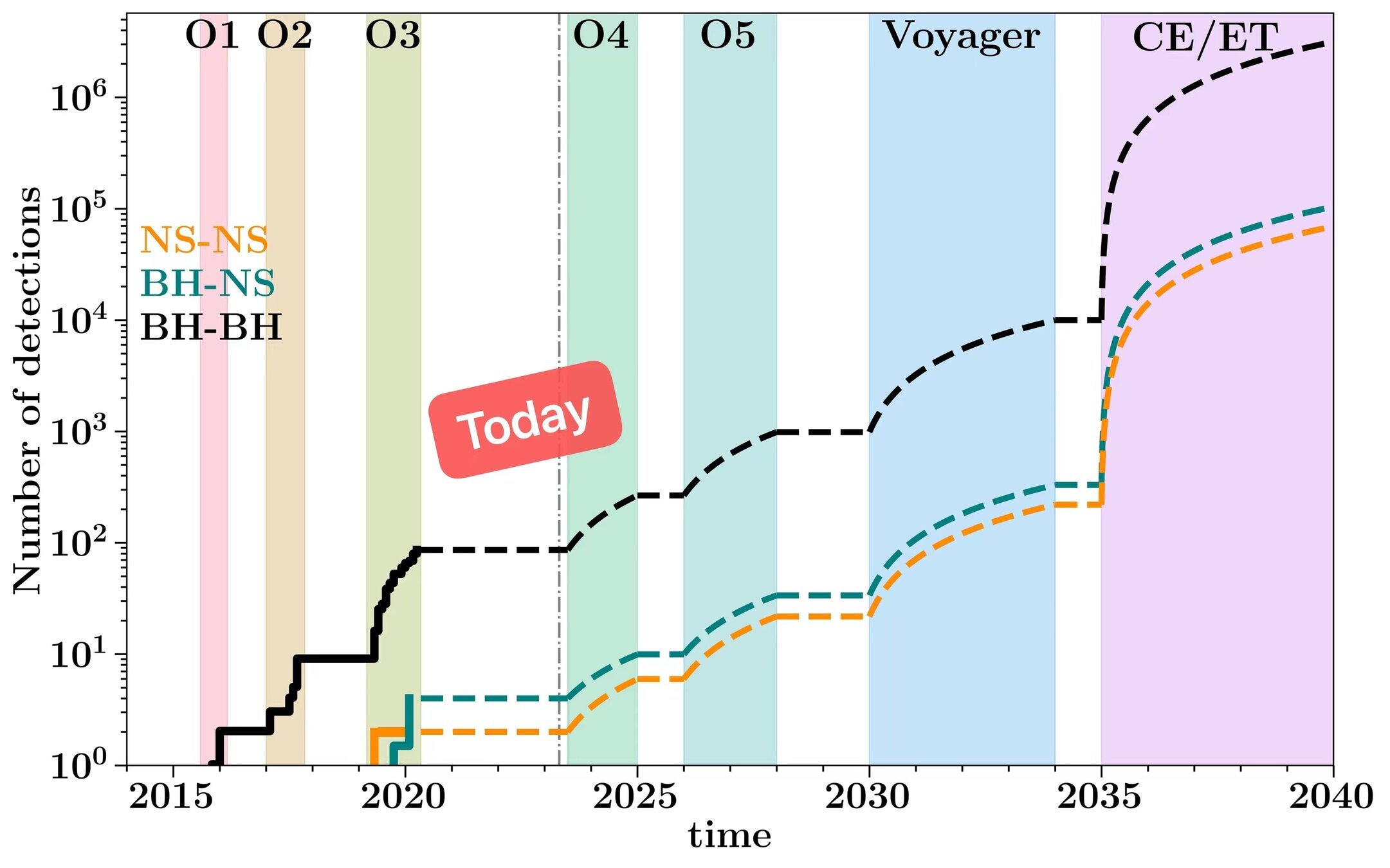Clearing the Path to Discovery: Detecting and Denoising Gravitational Waves with Deep Learning
王赫
hewang@ucas.ac.cn
中国科学院大学 · 国际理论物理中心(亚太地区)


Reference:
- PRD 107.2 (2023): 023021
- PRD 107.6 (2023): 063029
- PLB (2023): 137904.
- arXiv:2212.14283
- Gravitational Wave Astronomy
-
Gravitational Wave Detection
- MFCNN
- MLGWSC1
-
Gravitational Wave Observational Data Denoising
- WaveFormer
-
Outlook
- LLM / ChatGPT
- GWToolkit
- PE (DINGO)
Content
Gravitational Wave Astronomy
-
Fundamental physics
- Existence of gravitational waves
- To put constraints on the properties of gravitons
-
Astrophysics
- Refine our understanding of stellar evolution
- and the behavior of matter under extreme conditions.
-
Cosmology
- The measurement of the Hubble constant
- Dark energy

GWTC-3

The First GW Event: GW150914
- Detecting gravitational waves require a mix of FIVE key ingredients:
- good detector technology
- good waveform predictions
- good data analysis methodology and technology
- coincident observations in several independent detectors
- coincident observations in electromagnetic astronomy
—— Bernard F. Schutz
DOI:10.1063/1.1629411
AI for Gravitational Wave
- AI for Science \(\rightarrow\) AI for GW
- Artificial Intelligence (AI) has great potential to revolutionize gravitational wave astronomy by improving data analysis, modeling, and detector development.






AI for Gravitational Wave
-
GW Data characteristics:
-
Noise: non-Gaussian and non-stationary
-
Signal: A low signal-to-noise ratio (SNR) which is typically about 1/100 of the noise amplitude (-60 dB)
-


Data quality improvement
Credit: Marco Cavaglià
LIGO-Virgo data processing
GW waveform modeling
GW searches
Astrophsical interpretation of GW sources
Gravitational Wave Detection

PRL, 2018, 120(14): 141103.
-
Matched filtering techniques (匹配滤波方法)
-
In Gaussian and stationary noise environments, the optimal linear algorithm for extracting weak signals
-
- Convolutional neural networks (CNN) can achieve comparable performance to MF, and outperform them in terms of execution speed (with GPU support).
... under Gaussian stationary noise.


PRD, 2018, 97(4): 044039.
-
GW Data characteristics:
-
Noise: non-Gaussian and non-stationary
-
Signal: A low signal-to-noise ratio (SNR) which is typically about 1/100 of the noise amplitude (-60 dB)
-
Gravitational Wave Detection

Convolutional Neural Network (ConvNet or CNN)
- Test the CNN model on real LIGO recordings and GW events, the output is very bad 😰
Matched-filtering Convolutional Neural Network (MFCNN)
GW150914
GW151012


MFCNN
MFCNN

GPS time


GW150914
GW151012
GPS time
Wang H, et al. PRD (2020)
Gravitational Wave Detection
- 改进并开发神经网络模型,以适应真实的引力波观测数据的任务
- 匹配滤波算法当中的波形模板 \(\rightarrow\) 卷积层中的卷积核权重参数
- Matched-filtering layer (匹配滤波感知层)
- 可以准确探测到 GWTC-1 中的 11 个真实引力波事件,甚至包括 GW170817
- 可以直接应用于空间引力波数据场景,探测 MBHBs

GW170817
GW190412
GW190814
mass distribution

Ruan WH, Wang H, et al. PLB (2023)
Matched-filtering Convolutional Neural Network (MFCNN)

Wang H, et al. PRD (2020)
Gravitational Wave Detection
- 改进并开发神经网络模型,以适应真实的引力波观测数据的任务
- 匹配滤波算法当中的波形模板 \(\rightarrow\) 卷积层中的卷积核权重参数
- Matched-filtering layer (匹配滤波感知层)
- “神经网络化”的探测统计量 (匹配滤波信噪比)
Frequency domain
(whitening)
Time domain
(normalizing)
(matched-filtering)
where \(S_n(|f|)\) is the one-sided average PSD of \(d(t)\)

In the 1-D convolution (\(*\)), given input data with shape [batch size, channel, length] :
(A schematic illustration for a unit of convolution layer)
Matched-filtering Convolutional Neural Network (MFCNN)

Wang H, et al. PRD (2020)
Gravitational Wave Detection
- 改进并开发神经网络模型,以适应真实的引力波观测数据的任务
- 匹配滤波算法当中的波形模板 \(\rightarrow\) 卷积层中的卷积核权重参数
- Matched-filtering layer (匹配滤波感知层)
- “神经网络化”的探测统计量 (匹配滤波信噪比)
- Insight: 引力波信号处理 \(\rightarrow\) 智能引力波信号处理

Matched-filtering Convolutional Neural Network (MFCNN)

Wang H, et al. PRD (2020)


An example of transfer function:
CNN
RNN
Gravitational Wave Detection
- 改进并开发神经网络模型,以适应真实的引力波观测数据的任务
- 匹配滤波算法当中的波形模板 \(\rightarrow\) 卷积层中的卷积核权重参数
- Matched-filtering layer (匹配滤波感知层)
- “神经网络化”的探测统计量 (匹配滤波信噪比)
- The first machine learning gravitational wave signal search challenge (MLGWSC1) https://github.com/gwastro/ml-mock-data-challenge-1
H1
L1
search scope









(MFCNN group) Wang H, et al. PRD (2023)
Gravitational Wave Observational Data Denoising
-
Billion-scale transformer-based model (WaveFormer)
- Suppression on realistic noise, and
- Recovery of injections / GW events
-
Application:
- Data quality improvement

arXiv:2212.14283, DOI: 10.21203/rs.3.rs-2452860/v1

BEFORE
AFTER
Gravitational Wave Observational Data Denoising
-
Billion-scale transformer-based model (WaveFormer)
- Suppression on realistic noise, and
- Recovery of injections / GW events
-
Application:
- Data quality improvement



BEFORE
AFTER
Gravitational Wave Observational Data Denoising
-
Billion-scale transformer-based model (WaveFormer)
- Suppression on realistic noise, and
- Recovery of injections / GW events
-
Application:
- Data quality improvement



Bacon P. et al. arXiv: 2205.13513
Gravitational Wave Observational Data Denoising
-
Billion-scale transformer-based model (WaveFormer)
- Suppression on realistic noise, and
- Recovery of injections / GW events
-
Application:
- Data quality improvement



Bacon P. et al. arXiv: 2205.13513

Murali C & Lumley D. arXiv: 2210.01718


Wei W and Huerta E A. PLB 2020
Chatterjee C, Wen L, et al. PRD 2021
arXiv:2212.14283, DOI: 10.21203/rs.3.rs-2452860/v1
GW170823
Gravitational Wave Observational Data Denoising
-
Billion-scale transformer-based model (WaveFormer)
- Suppression on realistic noise, and
- Recovery of injections / GW events
- Data quality improvement


arXiv:2212.14283, DOI: 10.21203/rs.3.rs-2452860/v1
Outlook

- Large Language Model (LLM) for GW data analysis.

WaveFormer
Transformer: 750x / 2yrs
Outlook






- Large Language Model (LLM) for GW data analysis.
- Software development: GWToolkit powered by Ray.
Outlook
- Large Language Model (LLM) for GW data analysis.
- Software development: GWToolkit powered by Ray.
-
Parameter estimation: "Curse of Dimensionality"
- Multi-source events (overlapping signals / combining inference)
Recent Updates to Rapid PE
- Pathak et al. (2210.02706). Rapid reconstruction of compact binary sources using meshfree approximation
- Wofford et al. (2210.07912). Improving performance for GW PE with an efficient and highly-parallelized algorithm
- Islam et al. (2210.16278). Factorized PE for Real-Time GW Inference
- Digman & Cornish. (2212.04600). PE for Stellar-Origin Black Hole Mergers In LISA
- Yelikar et al. (2301.01337). Low-latency PE enabled by a Gaussian likelihood approximation for RIFT
- Wong et al. (2302.05333). Fast GW PE without compromises
- Tiwari et al. (2303.01463). VARAHA: A Fast Non-Markovian sampler for estimating GW posteriors
- Karnesis et al. (2303.02164). Eryn : A multi-purpose sampler for Bayesian inference
- Fairhurst et al. (2304.03731). Fast inference of binary merger properties using the information encoded in the GW signal
- ...

PRD 99, 124044 (2019)

Combining inferences from multiple sources

for _ in range(num_of_audiences):
print('Thank you for your attention! 🙏')This slide: https://slides.com/iphysresearch/gr2023
Outlook
- Large Language Model (LLM) for GW data analysis.
- Software development: GWToolkit powered by Ray.
-
Parameter estimation: "Curse of Dimensionality"
- Multi-source events (overlapping signals / combining inference)
Recent Updates to Rapid PE
- Pathak et al. (2210.02706). Rapid reconstruction of compact binary sources using meshfree approximation
- Wofford et al. (2210.07912). Improving performance for GW PE with an efficient and highly-parallelized algorithm
- Islam et al. (2210.16278). Factorized PE for Real-Time GW Inference
- Digman & Cornish. (2212.04600). PE for Stellar-Origin Black Hole Mergers In LISA
- Yelikar et al. (2301.01337). Low-latency PE enabled by a Gaussian likelihood approximation for RIFT
- Wong et al. (2302.05333). Fast GW PE without compromises
- Tiwari et al. (2303.01463). VARAHA: A Fast Non-Markovian sampler for estimating GW posteriors
- Karnesis et al. (2303.02164). Eryn : A multi-purpose sampler for Bayesian inference
- Fairhurst et al. (2304.03731). Fast inference of binary merger properties using the information encoded in the GW signal
- ...

PRD 99, 124044 (2019)

Combining inferences from multiple sources



©Floor Broekgaarden (repo)
Gravitational Wave Astronomy
- Looking towards the future of gravitational wave astronomy: O4 and beyond
LIGO-G2300554
AI for Gravitational Wave



-
2016年,AlphaGo 第一版发表在了 Nature 杂志上
-
2021年,AI预测蛋白质结构登上 Science、Nature 年度技术突破,潜力无穷
-
2022年,DeepMind团队通过游戏训练AI发现矩阵乘法算法问题
-
《达摩院2022十大科技趋势》将 AI for Science 列为重要趋势
-
“人工智能成为科学家的新生产工具,催生科研新范式”
-
-
AI for Science:为科学带来了模型与数据双驱动的新的研究范式
-
AI + 数学、AI + 化学、AI + 医药、AI + 物理、AI + 天文 ...
-
AlphaGo 围棋机器人
AlphaTensor 发现矩阵算法
AlphaFold 蛋白质结构预测
Gravitational Wave Observational Data Denoising
-
数据质量的提升是一个非常复杂的问题,超过 20 万个传感器通道的数据会决定引力波科学数据通道的质量
-
降低引力波数据中非高斯的短时脉冲波干扰 (Glitch),会有助于减少引力波信号误报率
-
引力波探测数据中去除 Glitch,是一个多分类问题
- 传统机器学习算法 Powell J, et al. CQG, 2015
- 深度学习算法 Zevin, M, et al. CQG, 2017; Razzano M, Cuoco E. CQG, 2018; Ormiston R, et al. PRR, 2020
- 与其消除数据的非高斯性,何不直接把信号重构出来?这有助于发现理论预言之外的引力波信号!

Extremely Loud Helix Koi Fish
Glitch cases

non-Gaussianess

Ormiston R, et al. PRR, 2020




